Earlier this month in the April edition of the Total Football Analysis Magazine, we ran a tactical theory piece on ‘Attacking With Inverted Wingers‘.
Along with giving a brief history of the position, we outlined the unique and often overlooked advantages of this role in the final third of the pitch.
I would recommend reading that article to maximise your understanding and learning in support of this training ground piece.
Otherwise, check out the fantastic video produced by Max Bergmann on ‘Attacking With Inverted Wingers‘.
This video gives a clear visual and tactical representation of the piece laid out in the April magazine.
The current era of the Premier League gives us many great examples of inverted wingers who are effective in developing and finishing prominent attacks for their teams.
To name but a few to observe who perform this role well; Sadio Mané and Mohammad Salah for Liverpool along with Raheem Sterling and Riyad Mahrez for Manchester City.
All of these are capable and effective at two things in particular, firstly, creating high-value chances for their teams from wide areas.
Secondly, they very often achieve a lot of secondary success for their team by drawing fouls to win penalties and free-kicks as well as corners.
Below we will give a tactical analysis of the position and the specific unique advantages it serves.
As well, the analysis progresses into a structured training ground piece where players can develop their understanding of tactics and how the inverted winger can positively affect their team in attack.
the unique advantages Of An Inverted Winger
I will preface by stating, the inverted winger is not superior to what you might consider an orthodox winger.
What is important to distinguish is your team’s style of play and whether that system supports the attacking flair of the inverted winger.
Should a coach look to play with an inverted winger then here are some of the unique advantages available to this player.
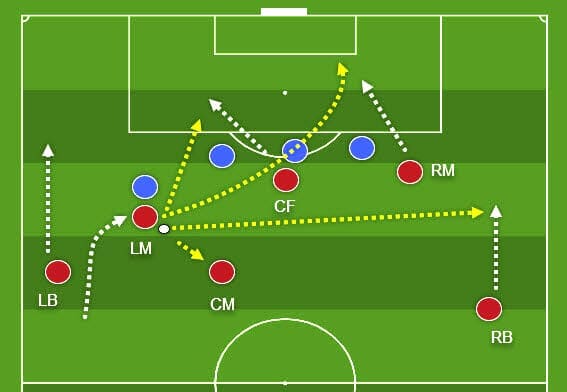
In no particular order, here are four distinct traits available to an inverted winger.
By cutting inside and engaging the opposition full-back, the winger serves to create space for the supporting full-back to overlap and become an option high and wide.
Immediately after cutting inside a gap can become available to play a penetrating pass into the blind-side run of the centre-forward to meet with and finish.
Should the inverted winger be at a sufficient distance and have an angle he can deliver an inswinging cross to the back post for either or both the centre-forward and the opposite winger to meet and score from.
Finally, When teams switch play, we generally see the course of passes go through the centre-midfielders or centre-backs.
However, by the inverted winger playing a long crossfield pass to his teammate on the opposite, the opponent’s weak side, he helps the ball arrive in a dangerous position before the opposition has time to organise and receive an attack.
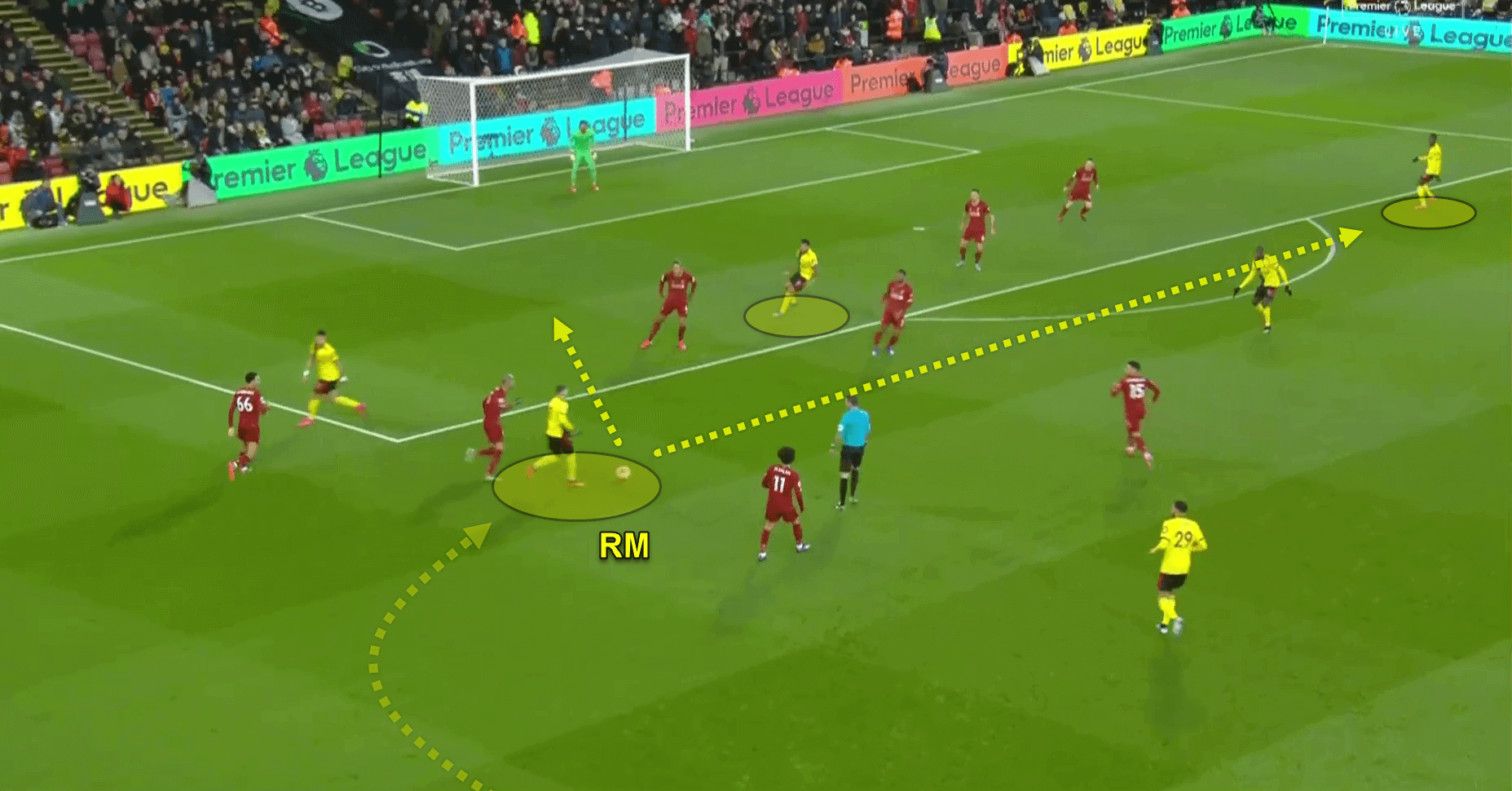
Above, we see an example of an inverted winger unbalancing a defence and discovering his options to penetrate from inside.
In the Premier League game between Watford and Liverpool, this past season Gerard Deulofeu carries the ball inside.
The right-footer operating from the left protects the ball on his safe side as he drives inside.
Central striker Troy Deeney can make a blind-side run on Liverpool’s Van Dijk to meet a potential pass from Deulofeu.
While the Spanish winger can play a Crossfield pass to his teammate on the opposite side to continue and develop a dangerous attack.
Inverted Winger Training Ground Rondo
Here we offer a three-part progressive training session that will support the attacking potential and learning opportunities of the inverted winger.
Although all practices are very rich in detail and coaching points make your players clear on the aims and objectives before they begin.
The first practice, in particular, can be used to target and develop so many aspects of the game, such as combination play, half-space penetrating and exploiting the weak side.

Practice #1 and #2 can be set up twice and mirrored on both sides of the field.
We thereby have smaller game realistic practices that engage all players with more touches of the ball.
Practice #3, however, brings all players together as we put all trained principles into practice in a conditioned phase of play.
Be flexible, depending on the age and ability of the players you may want to increase or decrease the size of the area.
Also, maybe add more defenders to make it harder or neutral players to get more success.
Whatever helps you achieve success, call on your expertise and critical thinking as a coach.
Practice 1: Developing Principles
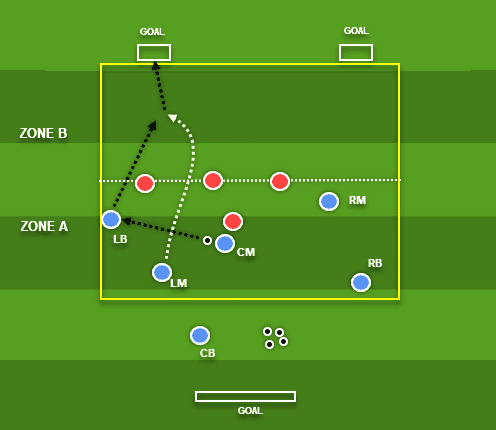
Organisation
- Play starts with the ‘CB’ of the blue team, as a forward pass goes into zone ‘A’.
- The Blues are looking to score in either of the small goals on the outside of Zone ‘B’
- For the blues to score, they must make the final pass/shot inside of zone ‘B’
- The blues cannot dribble over the dividing (offside) line nor can a player wait inside zone ‘B’ as they will be offside.
- The blues can only enter by playing an attacking pass forward into zone ‘B’ where a player can meet once he has made a run that successfully beats the offside line.
- The three red players on the line cannot move into zone ‘A’ to defend only one red can be in zone ‘A’ to roam free and apply pressure to the blues.
- Once play has reached Zone’ B’ all four red players can retreat in the zone.
- Once possession has been turned over and the red team transition to attack, they may move in into either zone.
- The objective for the red team is to win possession back, make one successful pass and score in the big goal behind the blue CB from a distance if they wish.
- The blues can play back to the CB at any time to re-circulate possession to the other side. However, the CB cannot come into zone ‘A’.
Coaching points
- Observe and execute good passing and movement principles first
- Create gaps to play penetrating passes by stretching the three red player block, maximise width.
- Promote rotations in the attack, to lose defenders and become unmarked
- Promote one-touch passes to penetrate when passing distances are short
- Exploit the weak side of the red team via switch through CB or a penetrating pass into zone ‘B’ to meet the attacking run from the red team’s weak side.
Practice 2: Game Realistic Practice
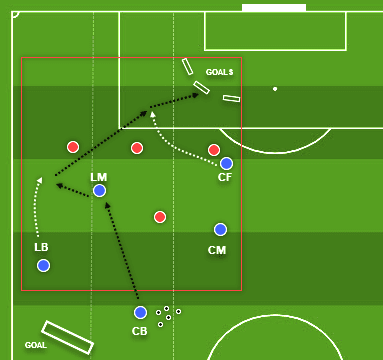
Organisation
- Similar organisation as before; however, players positions do not have to follow strictly, it is a guide for optimal learning.
- Now we progress to a more game realistic scenario whereby players play in their natural positions with natural distances relative to the opposition
- Blues are looking to score in either of the three small goals in the upper right-hand corner of the playing area.
- The red team are looking to win back possession and score in the big goal near the halfway line at their earliest opportunity, thus representing a successful T2A.
- Play starts with blue CB who plays forward to a free player, from there we are looking for functional movement and rotations from the supporting players.
- Offsides apply, and we are considered a quick free-kick for the red team if there is to be an offside
- The blue team can score in any of the three small goals from any distance at any point so the reds will need to apply realistic defensive principles to have any chance of success.
Coaching Points:
- Apply sound possession principles first, do not force any opportunity, good quality passes and movement as well as sprints for penetrating runs and good rotations
- Promote inversion for the winger to engage with one of the back three, supporting blue players should look to exploit the space provided by the red defender engaging the blue inverted winger.
- The inverted winger means the player more naturally positioned to create width is the full-back
- Thus, the full-back should utilise the highest-widest point while still being a realistic passing option from inside.
- Promote a good speed of play, to develop the players further on this topic. For example, offer an 8 – 15 second time limit for the Blues to score otherwise they turn over possession.
- Once reasonable confidence and efficacy have been achieved for the blue team, notify the players on the importance of success versus the challenge of transitioning to defend from this position.
Practice 3: Conditioned Phase of Play
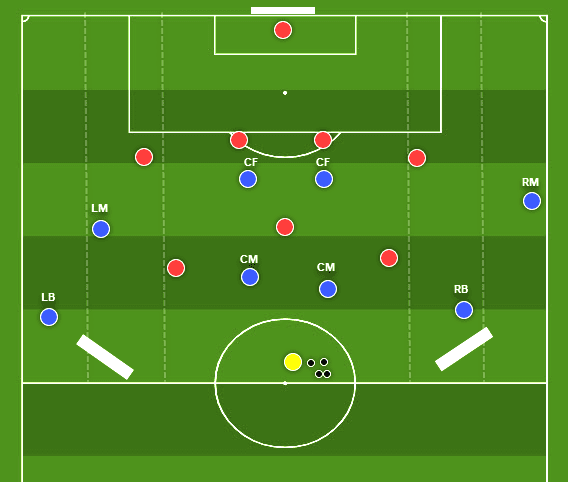
Organisation
- Eight blues attack the goal against seven red outfielders and one red goalkeeper
- The blues are set up in a 2-4-2 to honour the 4-4-2 formation however you can adjust and play to your preferred formation
- The red team play as a 4-3 with the support of the neutral (yellow) player when they T2A
- Play starts and restarts with the neutral on the halfway line, where the blues begin their attack on goal.
- The objective for the red team is first to defend successfully, then to score in either of the two wide goals near the halfway line at their earliest opportunity.
- The vertical broken lines represent the wide channels and the half-space just inside. These channels have an average width of 12 yards if you choose to play with them. The condition that can be applied to these channels is that no two players can be on the same channel at the same time. However, players have the freedom to move across channels, so awareness and rotations are a must from supporting players.
- The advantage these vertical channels offer is the tactical training as well as good habit training for players to move well and into the best positions to receive passes without direct pressure as well as to cause imbalance to the opponents back-line.
- Promote attacks in wide areas with the incentive for the inverted winger to affect the game with his or her out-to-in movement as well as using the advantage of having a view of the goal with their dominant foot in the final third.
Coaching Points
- Sound passing and movement principles should be applied
- Use four main attacking options of the inverted winger as frequently as possible to either penetrate the defence or further the attack.
- Options are; play to attacking full in the wide channel, play a central penetrating pass to CF, play an in-swinging cross to back post to CF and opposite winger or play a Crossfield pass to opponents weak side.
- You may want to coach the correct striker position for an in-swinging cross. However, considering the topic to be very rich in options and coaching points you may want to either make this a priority and coach it or facilitate this option in a ‘crossing and finishing session’ however I would highlight it to the players.
- Are unbalancing the opponent’s defence, are full-backs maximising their width, are strikers offering themselves as a target as the focal point in the attack and are we set up to exploit the opponent’s weak side.
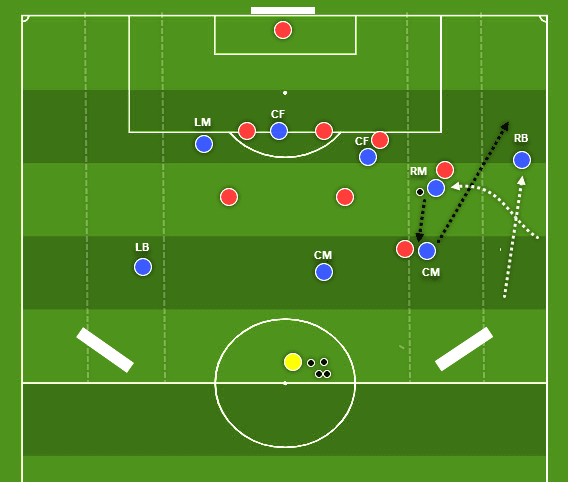
Above, is a tactical annotation to show the attacking advantages and potential of the inverted winger.
A realistic scenario of an inverted winger carrying the ball inside as he engages the opposition full-back, he serves to create space for the supporting full-back overlap and becomes an option in the channel via a pass from the CM if a reverse pass is not available.
The phase of play is very rich in potential attacking patterns and options, so the fewer the objectives and expectations, in the beginning, the better.
Final thoughts
Educate yourself and be clear about what you want to achieve from this topic.
One aspect although we mention but do not train in isolation here is the in-swinging cross.
The in-swinging cross is a play that requires collective thinking and preparation from the players.
The timing of runs, the timing of the cross and the positioning of the attackers at the back post require a lot more training than a bullet-point mention from the coach’s logbook.
Although it can be developed particularly from practice #3 with the support of crossing and finishing exercises as a pre-requisite.
Although we allow for ‘Coaching Points’ in each practice, do your best to save on them.
As coaches, we want our voices to be at a premium; however, to do that we need to limit our interruptions and messages to players in a high-tempo session.
That is not to say, be satisfied with repetitive errors and mistakes, far from it. Try to engage your players in video sessions of good examples of inverted wingers prior to the session.
Video footage from either your own team or even clips from the best teams in the game.
This will serve to create performance and tactical targets in the player’s minds before entering the training ground.
Coaching the inverted winger is a topic very rich in detail and coaching points, even at the highest level.
Make your aims clear to the players and help them enjoy the session.
If you have any questions, or you want to discover more, write to me on Twitter @easytactics and I’ll happily cover the topic in greater depth.
I recommend all coaches watch the Total Football Analysis video ‘Attacking With Inverted Wingers‘ to further their knowledge and understanding of this unique position.




Comments